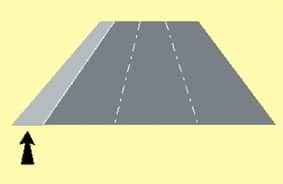Scan QR code or get instant email to install app

Question:
What should you use the hard shoulder of a motorway for?

Don’t use the hard shoulder for stopping unless it is an emergency. If you want to stop for any other reason go to the next exit or service station.
Related Information
What is the hard shoulder?
A hardened strip of land that runs along the edge of motorways to the left of the left-hand lane is called the hard shoulder. A solid white line separates the motorway's driving lanes from the hard shoulder, which has a standard width of 3.3 meters.
When to use a hard shoulder?
Apart from in an emergency, you are not permitted to stop on the hard shoulder or the emergency refuge areas on a smart motorway. Emergency situations include when your vehicle breaks down mechanically, when you get a puncture, when a trailer or any other items on your car becomes loose, or when you experience a medical emergency. You should schedule your rest stops around service stations rather than stopping on the hard shoulder if you need to make or receive a phone call, are tired, or need to use the restroom.
Additionally, unless instructed by a police traffic officer or a Highways England patrol, you cannot use the hard shoulder as a driving lane. The only exception is during roadworks, where yellow signs will let you know when a contraflow is in effect and moving lane one to the hard shoulder. You must move back to lane one after the contraflow has come to an end.
You are not permitted to pull over onto the hard shoulder to improve traffic flow on the main carriageway if you are exiting the motorway via a slip road but there is a tailback on that slip road. It can seem like a good idea, but you end up covering the road markings and blocking a possible emergency service access route. Additionally, drivers behind you might not be as careful and try to push in further up the queue, adding to the delays.
How to use a hard shoulder?
In order for oncoming traffic to see you when you need to stop on the hard shoulder, you should pull over as far to the left as you can and turn on your hazard warning lights, especially at night. It can be helpful to turn the steering slightly to the left before getting out of the car so that, in the worst case scenario, if another vehicle collides with your car, it will veer off to the left rather than back into the carriageway, where it could result in a more serious collision.
Make sure the handbrake is on before exiting the vehicle, then exit by the left-hand doors to avoid moving traffic. Find an emergency phone, the location of which will be marked with a large orange SOS sign, and use it to call for help. If you can, scan the area for any nearby motorway marker posts. These small white posts have a number printed on them as well as blue and red markings. This number is specific to your location and makes it simpler for emergency services to find you because it not only indicates where you are but also has markings that tell them which side of the motorway you are on.
It's best to remain away from the road once you get out of the car. Stand behind any concrete walls or armco barriers if they are present. If there is a rising embankment, move a bit higher to get out of the way; but, if there is a descending embankment, maintain level with the road so that other drivers and the services can see you. Put on a high-visibility vest, if you have one, to make yourself more visible.

Comments
kimia_mehrnia
3 years ago
I love its graphics
JollyRanchers59
3 years ago
This app helps me learn whilst being free. I can learn my weaknesses and aim to pass at higher score
#lovewordgames
3 years ago
Helping my daughter with the theory side of the test. Only wish we’d found it earlier on! Even I’m learning/getting reminded of what things mean again!